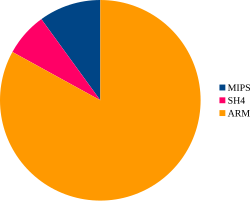| Linux.Wifatch | |
|---|---|
| Malware details | |
| Aliass | |
| Family | Virus |
| Author | The White Team |
| Technical details | |
| Platform | Linux |
| Written in | Perl [2] |
Linux.Wifatch is an open-source piece of malware which has been noted for not having been used for malicious actions, instead attempting to secure devices from other malware. [2]
Contents
Linux.Wifatch operates in a manner similar to a computer security system and updates definitions through its Peer to Peer network and deletes remnants of malware which remain. [3]
Linux.Wifatch has been active since at least November 2014. [4] According to its authors the idea for Linux.Wifatch came after reading the Carna paper. [5] Linux.Wifatch was later released on GitLab by its authors under the GNU General Public License on October 5, 2015. [6]
